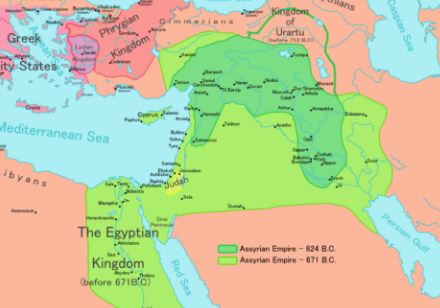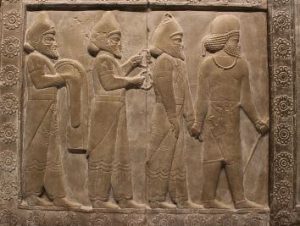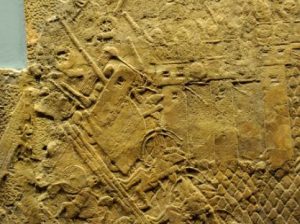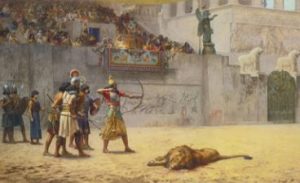The Tigris and Euphrates rivers are born in the mountains of Armenia and flow into the Persian Gulf. The extensive region which the basins of these rivers delineate is know by the name Mesopotamia. In Lower Mesopotamia the alluvium from the rivers carried land to the sea, and the floods, wisely channeled, fertilized the earth, which made possible a rich agriculture.
Upper Mesopotamia was a plateau very well connected to Syria and Egypt. The entire region was, from approximately 3000 B.C. until 539 B.C., the scene for brilliant civilizations, like the Sumerian city-states, which used the first known writing, cuneiform, and the Akkadian, Babylonian, Assyrian, and Neo-Babylonian Empires.
The Assyrians
Contents

Synthesis of their History
In 1500 B.C. when the Hittites returned to the north, after destroying the first Babylonian Empire, a long period of confusion began in Mesopotamia, and at this time a state called Assyria arose in the north, whose capitals were Nineveh and Assur, situated on the banks of the Tigris. In this area of the valley, agriculture had facilitated the development of civilization. In the beginning, the Assyrians constituted a rough frontier people; but with time they adopted the civilized life of other peoples of the valley.
The Assyrians were not a particularly peaceful people, but instead were characterized by the cruel, aggressive, and dominant; but it is possible that they were obligated to adopt this conduct in order to survive, as the history of Assyria during the greater part of the second millennium B.C. is plagued with invasions and counter-invasions of their powerful neighbors. In addition to the Hittites there were the Hurrians (a Caucasian people) and the Mitanni (Indoeuropeans).
The Assyrians, who were ferocious warriors of Semitic origin, had remained subject to various dominations until they began what could be called their first period of expansion, which began with Shalmaneser I (1270 B.C.) and ended with Tiglath-Pileser I (around 1100 B.C.).
At the beginning of the first millennium pre-Christ, the most powerful empire in Mesopotamia was formed, the Assyrian Empire, which dominated the region for several centuries. As remains of its might, the ruins of military forts remain, constructed with great blocks of stone, located in the different regions dominated in the times of its maximum expansion. Here a tower from the fort constructed by Shalmaneser III as part of the defenses of the city of Nimrud can be seen.
Two centuries later (around 910 B.C.) they renewed their expansionist activity, a process which led them to build a vast empire supported by terror and violence (from Media to the Nile and from the Persian Gulf to Lydia), which finished putting Ashurbanipal on a sound footing (669-633 B.C.) who subdued Upper Egypt (665 B.C.) on one hand, and on the other destroyed Susa (641 B.C.).
However, this formidable colossus soon began to experience the consequences of its own internal failings. In effect, the belligerent Assyrian nobility, of which the king was the chief, was always maintained based on war, without asking nor giving quarter. Thus the passing of the Assyrian armies was marked by atrocious tortures, fires, sacking of cities, exile of entire populations, and, above all, hate.
To said attitude was added the unmeasured exploitation of the subdued peoples, who they did not even try to attract. Thus in diverse regions like Babylonia, Egypt, and even in the area of Media, there arose military commanders who launched the populations, oppressed and ruined by the tribbutary charges and obligatory military service, against the very heart of Assyria.
On the death of Ashurbanipal, in 627 B.C., a revolution in the court followed. Of the events in Assyria after this date, little is known. The Medes took the city of Assur in 614 B.C., and, with Babylonian help, captured Nineveh in 612. The Assyrian army, directed by the last Assyrian king, Ashur-uballit II (who reigned from 612-609 B.C.), retreated to Harran, a certain distance to the northwest of the Assyrian capital. This defeat supposed the end of the Assyrian Empire.

In spite of the resistance of the Assyrians, who even called for help from the Scythian horsemen, the Medes took Assur (614 B.C.) and, two years later (612 B.C.), an alliance between Cyaxares and Nabopolassar culminated in the destruction of Nineveh, which was razed.
The Assyrian Empire extended itself in great measure due to its brutal military methods. It maintained its dominion by means of the use of a common language and religion, together with the violent suppression of internal revolts. The Chaldeans defeated the Assyrians in Babylonia, which gave as a result the Neo-Babylonian Empire, personified by Nebuchadnezzar.
Government
At its apogee, the Assyrian Empire was governed by kings whose power was considered absolute. Under their leadership, the empire came to be well organized. By eliminating the posts of governors which the nobles possessed by inheritance and instituting a new hierarchy of local officials directly responsible to the king, the Assyrian kings had greater control over the resources of the empire.
The Assyrians also developed an efficient system of communications in order to administer their empire in a more practical way. A network of mail stations was formed, which used relays of horses (and mules or donkeys in the mountainous lands) to carry messages throughout the whole empire. The system was so effective that a provincial governor from any part of the empire (except Egypt) could send a question to the king’s palace, and receive an answer in a matter of a week.
All the Assyrian art was inspired by that of Persia, Syria, the Hittites and Babylonia. Their statues are solid. Under the reign of Ashurbanipal the sculptors of animals achieved in bas-reliefs a grace and movement rarely equaled, which, since then, does not exist in the royal effigies with conventional features, with their curly beards and straight hair, in which only the Semitic profile and the thick lips offer a note of realism. Their architecture reflects power.
In the shelter of their battlemented walls, although more geometric, the fortified cities were not very different from their medieval counterparts. The gates were guarded by towers which impeded the attackers from charging the walls. In the interior, a citadel constituted the best refuge.
Elevated on an embankment, to which one arrived by means of a ramp, the palace of Sargon, in Khorsabad, appeared to be a true fortress, with its rectangular patios, onto which the storerooms opened, the deposits of iron ingots and the royal halls.
The whole ensemble was crowned with a ziggurat and in numerous chapels, the protector gods of Assur were worshiped. The pavement of the floors was made of adobe and the roofs were constructed in the form of brick terraces held up by beams.
Assyrian society and culture: Unlike the Hebrews, the Assyrians were not afraid to mix with other peoples. In fact, the Assyrian policy of deporting to Assyria many of the prisoners from recently conquered lands created a polyglot society in which ethnic differences were not important. It is estimated that, during a period of three centuries, between four and five million people were deported to Assyria, which produced a mixed population from the racial and linguistic point of view.

That which assured the Assyrians themselves of their identity was their language, although even this was similar to that of their southern neighbors in Babylonia. Religion was equally a cohesive force. Assyria was literally “the land of Ashur,” in reference to their principal god. The king—human representation of the god Assur—gave a final perspective of unity.
Agriculture made up the principal base of Assyrian life. Assyria was a land of country villas and relatively few important cities, above all in comparison with the southern part of Mesopotamia. Unlike the river valleys—where agriculture required the meticulous organization of a great number of people to control irrigation—the Assyrian agricultural fields received sufficient humidity from the regular rains.
Commerce was the activity which came second in economic importance. Interior commerce depended on a system which utilized metals—like gold, silver, copper, and bronze—as a means of exchange. Diverse agricultural products also served as a form of payment of or exchange. Due to their geographic location, the Assyrians functioned as intermediaries and participated in international trade, from which they imported wood, wine, metals, and precious stones, while they exported textile materials or fabrics woven in the palaces, temples, and private houses.
The culture of the Assyrian Empire was hybrid by nature. The Assyrians assimilated many elements of Mesopotamian civilization and considered themselves guardians of the Sumerian and Babylonian culture. For example, Ashurbanipal collected a large library in Nineveh, which included the available works on Mesopotamian history. The Assyrian religion also reflected the assimilation of other cultures. Although the Assyrians considered their own national god, Ashur, their principal deity, they also recognized nearly all of the gods and goddesses of Mesopotamia.
Among the better-known objects of Assyrian art are found the sculptures in relief found in the royal palaces of three of the Assyrian capital cities: Nimrud, Nineveh, and Khorsabad. These relieves—begun during the reign of Ashurbanipal in the 9th Century and which reached their culmination in the reign of Ashurbanipal in the 8th Century—illustrated two distinct types of motifs: the ceremonial or ritual scenes, grouped around the person of the king, and scenes of war and the hunt.
These last showed instances of action lived by the king and his warriors fighting battles or hunting animals, above all, lions. These relieves illustrate a vigorous masculine world, where discipline, brute force, and roughness are lasting values: in truth, the true values of the Assyrian military monarchy.
The Assyrian civilization was a hybrid civilization, in which there was a confluence of Babylonian, Hittite, and above all Syrian elements. Because of this Assyria did not cease to be a crucible which fused the different culture of the Middle East and contributed to spreading Babylonian contributions.
Thanks to the Assyrians, the Hittites would find grammatical texts which treat Mesopotamian language and writing. The royal Assyrian texts were engraved on stones and iron plaques, which cover the walls of the palaces, and in the library of Ashurbanipal are found a great number of treatises on astrology and Babylonian legends, written on clay tablets. These were engraved when the clay was still fresh, and were cooked later.
Missives were sent wrapped in an envelope, also of cooked earth, on which figured the address of the recipient and a text of “protection.” Writing was also done on wooden tablets covered with wax and in the same way writing with ink over wood, parchment, or papyrus was probably used. Numerous bilingual and trilingual dictionaries have been found, methods for learning Babylonian and Assyrian, as well as numerous copies of literary works, written in cuneiform characters.

Like the Sumerians and the Babylonians, for writing their language—an Akkadian dialect, related to the Semitic languages, Hebrew, Aramaic, and Arabic—the Assyrians employed characters which, written from left to right in horizontal lines, were very complicated. Because of this, beginning in the reign of Sargon I, the use of Aramaic language and writing—which were syllabic and therefore easier—would expand more and more, not only among the people, but also in the court.
The kings of Assyria had the important events of their reign recorded with great care. Thus we owe to Ashurbanipal the formation in Nineveh of an immense library, whose vestiges have allowed us to know the history of their dynasties, their conception of the world and the relationships which thus existed between the gods and the men of the country of Ashur.
The Gods and the Royal Hunt
As much in the life of the people as in that of the kings, religion represents one of the most important factors: it was the gods who introduced the Assyrian king as their vicar, charged with administering the country which belongs to them and punishing the pagans.
Under the reign of Tiglath-Pileser I, the most important gods were: Ashur, supreme lord in charge of the inauguration of the kings; Enlil, father of the earthly gods and of the countries; Sasmas, god of the sun; Sin, god of the moon; Adad, god of the storm, and, finally, Ninurta, god of war and the hunt. The goddess Ishtar, the descendant of the ancient mother-goddess, presides in war and love.
The cults were not immovable, and the gods were frequently supplanted by others in the adoration of men. Under the king Tukulti-Ninurta, the god of the hunt, Ninurta, was imposed above all others; under Ashurnasirpal I, Ishtar received all favors, while beginning in the reign of Adad-Nirari III, Marduk and his son Nabu were worshiped not only in Babylon, but also in all of Assyria. With each renovation of the cults, new temples were raised and new cities were founded. Some cults crossed the borders of Assyria and expanded through the entire Middle East. Such occurred, for example, with that of the goddess Ishtar.
One of the most curious aspects of the Assyrian religion appears profusely illustrated in the royal rites of the hunting of the lion: the king, symbolizing divinity, should hunt the lion, symbol of the forces of evil. In the same way, the king must hunt and take down with his own hand numerous other wild animals, like mountain goats, deer, bulls or elephants, with the object of being able to offer them in an annual sacrifice to Ashur. Numerous bas-reliefs show us the king hunting in the desert or pouring libations over the dead animals.
The other religious rites do not appear to differ much from the usual rites from the same time in Babylonia, and the practice of religion consisted, above all, in rites intended to earn the favors of the gods and to assuage their anger when some catastrophe occurred. The priests dedicated themselves to divination by means of examining the liver of the sacrificed victims, to the elaboration of calendars indicative of fast days and ill-omened days, to astrology and to all the magic sciences.
Philosophically, the Assyrian religion, like that of Mesopotamia, is religion without hope, without a life in the beyond, only occupied with earthly well-being. Demons or malicious genies are the cause of all the misfortunes which weigh on man. Through enchantments or magic rites, the priest-doctor was to wipe out the maleficent power of these genies and make sacrifices to the gods, so that they would again grant their protection to the man that had sinned but repented.
The rites were recorded in numerous treatises, which the priests and scribes interpreted, the only ones capable of deciphering the cuneiform characters.
Historic Moments
While Sargon was king of Assyria his principal preoccupation was the Israelites and the threats which lurked in certain peoples of the north and east like the Cimmerians and the nomadic Scythians, who rivaled them for more humid and fertile lands in which to pasture their flocks, until in 705 B.C., their ferocity defeated Sargon, who fell in battle.

His successor, Sennacherib, moved the point of view of the Assyrians to the south, towards Babylon, in modern day Iraq, a city famous for its laws, science, and astronomy. Repeated times it was captured. Over and over the people rebelled, until it finally succumbed and became the Assyrian capital under the king Esarhaddon, who in continuation directed his view towards the west, towards the greatest of prizes: Egypt.
In 671 B.C., Esarhaddon attacked and sacked that historic land, and made the Assyrian Empire, which now extended from Egypt to India, the greatest that the world had seen. However, his legacy did not last too long and on the death of his son, the king Ashurbanipal, in 627 B.C., the empire, exhausted by wars, was incapable of resisting the Scythians and Cimmerians (Ashurbanipal was the monarch who constructed the famous library with its 20,000 cuneiform tablets and the royal palace of Nineveh).
With the decline of Assyrian power, Babylonia again became independent. In 612 B.C. its armies finished off the Assyrians and sacked their capital at Nineveh, and before attacking closed the most solid alliance possible with the irritating Scythians. Unfortunately for the Jews of Jerusalem, the rise of an independent Babylonian power was not good news. The Babylonian state grew in power until reaching its zenith with the reign of the fearsome king Nebuchadnezzar who governed between 605-562 B.C.
